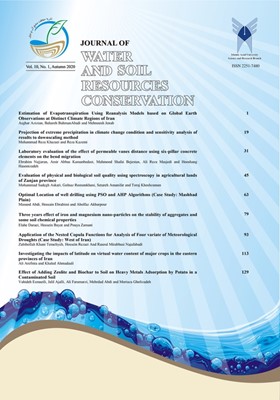Location of well drilling using PSO and AHP algorithms ( Case Study: Mashhad plain)
Subject Areas : Farm water management with the aim of improving irrigation management indicatorsmasuod abdi 1 , hossein ebrahimi 2 , abolfazl akbarpur 3
1 - Department of Civil engineering, Kish International Branch, Islamic Azad University, Kish Island, Iran
2 - Department of Water Science and Engineering, Shahr-e-qods Branch, Islamic Azad University, Tehran, Iran
3 - Department of Civil engineering, Birjand University, Birjand, Iran
Keywords: Hierarchical Analysis, Groundwater, Particle swarm optimization,
Abstract :
Determining the optimal number of required wells and pumping flow and selecting the place of drilling wells to meet the water needs of different uses is one of the important issues of water resources management in arid and semi-arid regions.The results showed that changing the coordinates of wells due to the variable thickness of the aquifer and also different water quality in different areas, will affect the cost of extraction and water treatment, respectively, and on the other hand, the distance from the place of consumption will increase the cost of transmission Changing the pumping flow of wells will also affect the energy consumption of the pump in the process of water extraction and transfer. Based on the results, the cost of the optimal design has been reduced by about 10% compared to the existing design. The results showed that water level drop and groundwater quality had the highest weight coefficient.Also, the areas that had the most drop, the best water quality, the shortest distance and the lowest height to the place of consumption, had the highest weight coefficient and the areas that had the lowest drop, The average annual drop in water level in this area varies from 1.13 to 0.3 meters. There are 422 deep wells in this area, about 60 of which have a discharge of more than 20 liters per second and are a good option for replacing the city's drinking water supply wells.
اقتصادی، ف. قاسمیان، د. خیرخواه زرکش، ت. وثقفیان، ب.1390. مکان یابی مناطق مناسب تغذیه مصنوعی با استفاده از شبکه عصبی مصنوعی به منظور مدیریت آبهای زیرزمینی در منطقه شهریار استان یزد. ششمین کنگره ملی مهندسی عمران، دانشگاه سمنان، سمنان، ایران.
رمضانی مهربان، ت.، ملک محمدی،ب.، جعفری، و رفیعی، ی.1390. مکان یابی محل های انجام عملیات تغذیه مصنوعی آبهای زیرزمینی با بکارگیری روشهای تصمیم گیری چند معیاره و سامانه اطلاعات جغرافیایی مطالعه موردی: استان هرمزگان، دشت شمیل و آشکارا (مجله علوم و مهندسی آبخیزداری ایران، (14 )14-1.
فهرست بها، 1398 سازمان برنامه و بودجه کشور
قاسمی نژاد، ا. 1394. برنامه ریزی چند منظوره تخصیص منابع آب با در نظر گرفتن اهداف کمی و کیفی (مطالعه موردی: مخزن دوستی). کارشناسی ارشد پایان نامه ، دانشگاه شهید بهشتی
علیزاده، ا.1386. اصول هیدرولوژی کاربردی، انتشارات دانشگاه امام رضا، مشهد، چاپ سی و یکم
معروفی، ا. ترنجیان، ا. و زارع ابیانه، ح. 1388. ارزیابی روشهای زمین آمار جهت تخمین هدایت هیدرولیکی و ph زه آبهای آبراهه همدان بهار. مجله پژوهش های حفاظت آب و خاک دانشگاه علوم و کشاورزی و منابع طبیعی گرگان. 169-178: (2) 16.
وزارت نیرو، 1392. استاندارد شماره 577 صنعت آب
Arumugam, M. S, and M. V. C. Rao (2008) “On the improved performances of the particle swarm optimization algorithms with adaptive parameters, cross-over operators and root mean square (RMS) variants for computing optimal control of a class of hybrid systems,” Applied Soft Computing Journal, 8(1), pp. 324–336.
Ayvaz MT, Elçi A (2013) A groundwater management tool for solving the pumping cost minimization problem for the Tahtali watershed (Izmir-Turkey) using hybrid hs-solver optimization algorithm. Journal of Hydrology 478:63–76.
Bertolini, M., Braglia, M. and G. Carmignnani (2006) Application of the AHP methodology in making a proposal for a public work contract. International Journal of Management , 88: 1384-1395.
Chaudhry S (2003) Unit cost of desalination. California Desalination Task Force, California Energy Commission, Sacramento, California.
Eberhart RC, Kennedy J (1995) A new optimizer using particle swarm theory. In: Proc. of the Sixth International Symposium on Micro Machine and Human Science (MHS-1995), 4-6 October, Nagoya, Japan, 39-43
Ch S, Kumar D, Prasad RK, Mathur S (2013) Optimal design of an in-situ bioremediation system using support vector machine and particle swarm optimization. Journal of Contaminant Hydrology 151:105–116.
Conkling H (1946) Utilization of ground-water storage in stream system development. Transactions of the American Society of Civil Engineers 111(1):275–305.
Elçi A, Ayvaz MT (2014) Differential-evolution algorithm based optimization for the site selection of groundwater production wells with the consideration of the vulnerability concept. Journal of Hydrology 511:736–749.
Hsiao C-T, Chang L-C (2002) Dynamic optimal groundwater management with inclusion of fixed costs. Journal of Water Resources Planning and Management 128(1):57–65.
Huang C, Mayer AS (1997) Pump-and-treat optimization using well locations and pumping rates as decision variables. Water Resources Research 33(5):1001–1012.
Katsifarakis KL, Petala Z (2006) Combining genetic algorithms and boundary elements to optimize coastal aquifers management. Journal of Hydrology 327(1-2):200–207.
Kennedy,J (1998) The behavior of Particle, Porto,V. W., Saravanan, N., Waagen,D., andEiben,.A.e.(eds),In:Evolutionary Programming VII,Springer,581-590.
McKinney DC, Lin M-D (1994) Genetic algorithm solution of groundwater management models. Water Resources Research 30(6):1897.
Mohtashami, A, Monfared SAH, Azizyan G, Akbarpour A, (2020) Determination of the optimal location of wells in aquifers with an accurate simulation-optimization model based on the meshless local Petrov-Galerkin. Arabian Journal of Geosciences 13, 26.
Sadeghi tabas S, Samadi SZ, Akbarpour A, Pourreza Bilondi M (2016) Sustainable groundwater modeling using single-and multi-objective optimization algorithms, Journal of Hydroinformatics, 18(5), pp. 1-18, 2016.
Storck P, Eheart JW, Valocchi AJ (1997) A method for the optimal location of monitoring wells for detection of groundwater contamination in three-dimensional heterogeneous aquifers. Water Resources Research 33(9):2081.
Ozcan, R. 2007. Assessment of the water quality of troia for the multipurpose usages. Springer Sience. Environmental Monitoring and Assessment, 130: 389-400.
_||_

